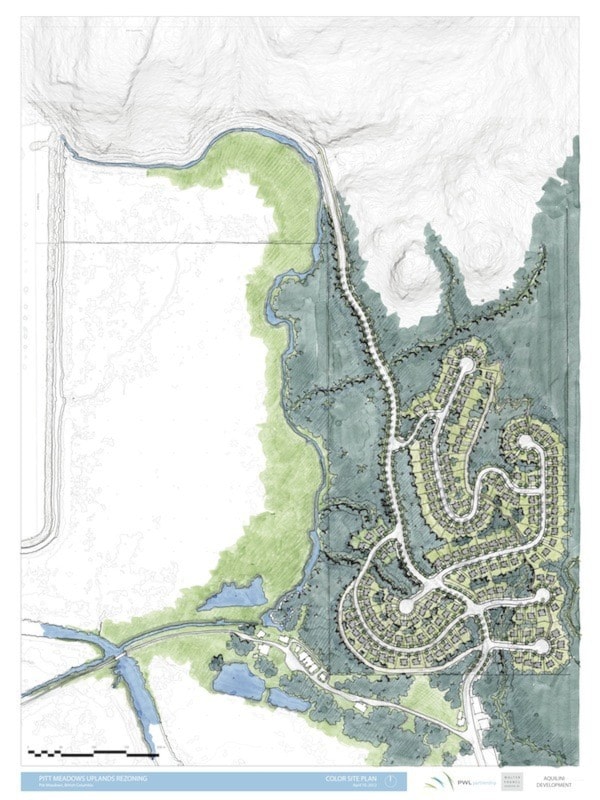The Aquilini Group is mulling a housing development on land it owns in northeast Pitt Meadows, at the edge of a protected nature reserve.
Pitched to city council on Tuesday as a green, sustainable project, the 59 hectare (146 acre) property is located on a hill near the Malcolm Knapp UBC Research Forest, above the Codd Island Wetlands, a nesting and roosting area for many bird species, including the red-listed Greater Sandhill Crane.
Aquilini Development and Construction Inc. is proposing 148 houses on the site, a significant increase from the 55 homes allowed the current zoning, Rural Residential 2.
The total footprint of the development would cover between 10 and 12 per cent of the 146-acre site, preserve “as much green as possible,” and the streams that run through it.
Development manager Riaan De Beer hopes to submit a formal development proposal to the city within six months, but only if the project is received favourably by council and the community.
“We are here to get the blessing for us to go out into the community,” he told Pitt Meadows council on Tuesday.
“We want to start off on the right foot and we are hoping to set the tone right, right from the beginning.”
The Aquilinis – who own the Vancouver Canucks – are also proposing to place covenants on several parcels of land in the Pitt Polder to ensure they will be preserved as farmland. Each of those parcels would currently allow for 93 “estate-style” homes.
The development proposed would be Leadership in Energy and Environmental Design certified.
It would also have its own sewage treatment plant, a storm water runoff system and filtration plant, drawing water through a well, which would be sunk next to a nearby lake.
“It’s a creative concept to solve estate housing on agricultural land, which is plaguing all municipalities,” said De Beer.
“What we are doing is aggregating residential development on a rather large piece of agricultural property and proposing to concentrate it in a relatively small area.”
De Beer noted even the Agricultural Land Commission, the provincial body tasked with protecting farmland, likes the idea.
“They are going to put some land into the [Agricultural Land Reserve], which always should have been in the ALR anyway, from our perspective that works,” said Tony Pellett, a planner with the land commission.
“On the face of it, it looks positive ... but that doesn’t mean it is positive from every perspective.”
Walter Francl, project architect, sees it as a “model for potential development in the rural area.”
“This is an opportunity to take a disparate group of single family homes that would be spread across the valley and consolidate it on a property that is already zoned for human habitation,” Francl said.
Pitt Meadows council, however, found little to like about the Aquilini proposal. Several councillors noted the high costs of providing police and fire protection services to a neighbourhood tucked away on a hill.
Others worried the project would be the first herald of sprawl, despite an assurance from the Aquilini group that the development will not grow larger.
“I see this as the thin edge of the wedge,” said Coun. Janis Elkerton.
“We were into business development in this community. We already have our share of residential development. I see this as a whole lot of resources being wasted for a select few.”
Given the history of opposition to development in the polder, council doubted the wider community would find anything positive about the project.
The Sturgeon Slough bridge on Neaves Road that leads to the Swan-e-set Golf Course was torched on Sept. 6, 1997 during a heated battle between environmentalists and the golf resort’s owners.
The resort’s plan – which included construction of 450 homes, a hotel and conference centre – were at the heart of a polarizing community debate that lasted more than a year and eventually saw municipal bylaws overturned in court.
The Pitt Polder Preservation Society, formed in response to the Swan-e-set project, was pleased to see council resoundingly pan the Aquilini proposal.
“It’s another pocket development,” said society president Diana Williams, who listened to De Beer’s presentation to council on Tuesday with a sense of deja vu.
“We heard a similar thing when Swan-e-set wanted to build – that it was going to be wonderful and wisely done. It’s sprawl out in the polder for heaven’s sake.”
NDP MLA Michael Sather, a member of the Polder society and a biologist, is concerned about the proposal’s impact on the ecologically unique Codd wetlands.
“It’s one of the few remaining wetlands in the Lower Mainland,” said Sather.
“It’s been set aside as a park and nesting area for the Sandhill cranes. It’s a very critical area and having that much disturbance in the area could cause them to leave. It just wouldn’t be good at all for the cranes.”
Codd wetlands
The Codd Island Wetlands encompass just over 101 hectares (250 acres) in the northeast corner of Pitt Meadow, which were originally slated for a commercial cranberry operation.
The property was collectively purchased in 2004 by The Land Conservancy, Metro Vancouver, the City of Pitt Meadows, province and Ducks Unlimited.
Along with all the mammals and reptiles using the area, significant populations of salmon species – including the blue-listed cutthroat trout – coho and chum salmon utilize the wetlands and associated creeks for spawning and rearing.
The Codd wetlands, along with the Blaney Bog – located just two kilometres upstream – provide the largest off-channel rearing habitat within the Alouette River watershed and are one of the last in the lower reaches of the Fraser River.
